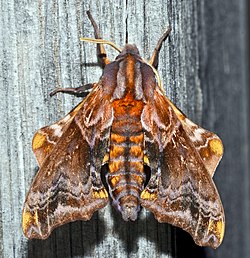| Small-eyed sphinx | |
|---|---|
 | |
| Scientific classification | |
| Kingdom: | Animalia |
| Phylum: | Arthropoda |
| Class: | Insecta |
| Order: | Lepidoptera |
| Family: | Sphingidae |
| Genus: | Paonias |
| Species: | P. myops |
| Binomial name | |
| Paonias myops (J. E. Smith, 1797) [1] | |
| Synonyms | |
| |
Paonias myops, the small-eyed sphinx, is a moth of the family Sphingidae. The species was first described by James Edward Smith in 1797.



